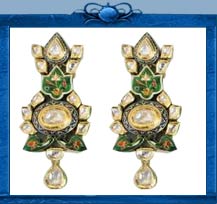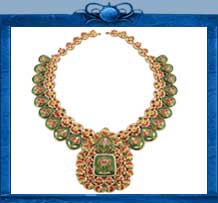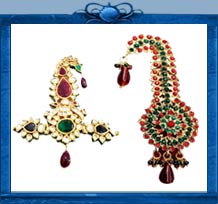KUNDAN JEWELRY
Kundan jewelry is a traditional jewelry that is very much exclusive to India. Kundan Jewellery is available in unique colors and designs. Indian Kundan Jewellery market is fast catching up as one of the trendiest ornaments. The gold used in making Kundan Jewelry is of completely refined quality. The process through which precious stones, gems and beads are set on the gold ornament is known as Kundan by the craftsmen. Making Kundan jewelry requires lot of skill and a fine eye for details.
Kundan jewelry is usually not set on solid gold. The central part of Kundan jewelry is made of lac, which is as a kind of solidified tree resin. The hollow jewelry pieces that are mostly joined to make the Kundan jewellery are bored with holes where precious stones and gems are inserted. Since the lac is visible from the holes, very highly refined gold is poured into it in order to cover up those holes. The stones are then set or rather pushed into the cool but pliant gold. When the gold finally hardens,the stones get embedded in it.
Kundan jewelry has even become very attractive even in urban India recently though it was worn since ancient times. Kundan Jewellery was in vogue in the state of Rajasthan during the empire of the Rajputs when the rich kings used to prefer such jewelry that was inlaid with precious gems and stones. Exquisite Kundan jewelry was in high demand in the royal household and with its intricate carvings which were the most sought after designs. Today, this set of jewelry has become more affordable and are considered to be one of the trendiest fashion symbols. Many young girls usually buy Kundan Jewelry sets for auspicious occasions since they give a grand look with ethnic Indian clothes.

It was during the Mughal period that the art of kundan work reached Rajasthan from Delhi. Then later on the craftsmen from the different part of the country migrated to the place and made Rajasthan a hub of Kundankari. Rulers and feudal lords also gave patronage to the art and it developed into perfection. Today, Kundankari is famous all over the world, with Rajasthan serving as its epicenter. Kundankari is basically embedded with gold and silver jewelry. The beauty of kundan work in the jewelry lies in the precise setting of stones into kundan and the overall look of the ornament.

Traditional kundan jewelry has stones embedded on one side and colorful and intricate meenakari on the reverse. The whole technique of Kundankari lies in the skillful setting of gems and stones in gold, which is rarely solid. Holes are cut in shapes for the gems, engraving is carried out and the pieces are enameled. The core of the ornament is made out of lac, a natural resin. Later, lac is inserted into the hollow parts and is then visible from the front, through the holes left for the gems. Highly refined gold or kundan is used to cover the lac and gems are then pushed into the kundan.
To increase the strength of the joints in the gold and silver and also to give it a smooth finishing, more kundan is applied. Kundankari is such a kind of specialized work which is carried by a group of craftsmen, each carrying out a specific task. The chiterias are the one who make the basic design, the ghaarias are usually responsible for engraving and making holes, meenakari or enameling is done by the enameller and the goldsmith takes care of the Kundan or gold. The jadiyas or stone setters, set stones such as jade, agate, garnet, emerald, rock crystal, topaz, amethyst, and spinel into kundan.


